The Mille Miglia is one of the world’s classic road races. Travelling 1,000 miles around Italy over four days, we thought this would be an ideal opportunity to check out some of the fuel economy credentials of the new Jaguar XE. Could we follow the race on one tank of diesel? Well, we like a challenge...
Stirling Moss, in a Mercedes-Benz SLR, emblazoned with the now legendary number 722, set the record finish for the Mille Miglia in 1955. His average speed that year was almost 100mph – allowing Moss and co-pilot Dennis Jenkinson to finish in just over 10 hours.
Although the venue was appropriate, with nine Jaguar team entries (among a total of 36 Jaguar cars participating in the Mille Miglia) many of which had their own motorsport heritage with Le Mans and other race entries back in the day, we would be less concerned with average speeds and more with average fuel consumption.
The Jaguar XE is one of the most important cars the brand has ever launched. Perhaps the most important. Squaring off against the BMW 3 Series, Audi A4 and Mercedes-Benz C-Class, the XE will be trying to establish Jaguar as a serious player cross the world.
Key powerplants behind this expansion are a new fuel-efficient 2.0-litre diesel engine in 163hp and 180hp outputs. We decided to choose the higher output version because it comes with a slightly larger fuel tank, meaning although it isn’t quite as fuel efficient as the entry-level engine, it has a better chance of traveling further. Using the official combined fuel consumption figure of 74.3mpg for the 163PS car, a maximum range of 768 miles is theoretically possible from the 47-litre tank. But the 180PS diesel has a 56-litre tank, and has an official combined fuel consumption figure of 67.3mpg, so 829 miles should be possible.
Were we being too optimistic? Maybe.
The route we were travelling on runs broadly in parallel to the Mille Miglia course, joining it at some points to get close to the participant cars (all of which must have been produced before 1958), and using motorways elsewhere to get ahead of the race cars and witness their arrival.
Day one – Brescia to Rimini
Many years ago, I took part in a fuel consumption challenge organised by the RAC for Fleet News.
In Vauxhall Vectra 2.2 DTi models, we were encouraged to see how far we could drive around and urban and out of town route in Berkshire until half a gallon on fuel was used (as measured by the car’s sophisticated trip computer), then calculate the average.
The Vectra’s official combined fuel consumption figure was 43.5mpg, and with one of the RAC’s fuel economy experts in the passenger seat, we managed to hit 56mpg for the route. A few did even better than that.
Since then, as fuel economy and CO2 emissions have become much more competitive, and car manufacturers have become more skilled at ensuring vehicles perform better in the tests, carried out on a rolling road under lab conditions. Owners have increasingly realised that the official combined fuel consumption figure – often viewed as an ‘average’ – has become almost impossible to replicate in real life driving.
Our XE would be part of a convoy of modern Jaguars, following the progress of the official team participants. Our challenge meant we would at times be driving much slower than the rest of the convoy. Perhaps painfully slow by comparison, just to see if 1,000 miles was achievable without a pitstop for fuel.
In 30ºC heat of day one, switching off air conditioning to try to save fuel was impractical. There were three occupants in the car including myself, and all of us brought luggage for three nights away. I began to wonder if we had any serious chance of hitting 81mpg at all, let alone make the fuel last for the round trip.
We headed toward Verona at around 4.30pm where we would pick up the Mille Miglia route toward Ferrara, then Bologna before picking up the autostrada to Rimini for an overnight stay, in time to see the first race cars arrive. Heavy traffic leaving Brescia got us off to a poor start, but soon where the roads were less congested, smooth acceleration and gradually adjusting speed to the road conditions paid dividends.
While monitoring fuel use for the journey, we used the trip computer to get an idea of what the XE was capable of. Using out-of-town roads with free-flowing traffic, we had seen an indicated 68.9mpg, which helped offset some of the poor fuel consumption earlier. And while the convoy pulled into a filling station near Ferrara (for coffee only), a crowd had gathered. Not to see the cars in our convoy, but for get a closer look at a fire-engine red Mercedes-Benz SSK being piloted in the Mille Miglia by former F1 and Le Mans racer Jochen Mass.
After gulping down a cappuccino and heading on our way, I took a stint in the passenger seat, leaving the economy run in the capable hands of my co-driver. We arrived in Rimini after dark having achieved an indicated 60.1mpg for the route. If this was going to work, we needed to try harder on day two.
Day two – Rimini to Rome
It felt like an early start but it was nowhere near early enough, resulting in us getting snarled up trying to exit Rimini and sending the fuel consumption for this part of the trip down into the low-20s, expounding the fact that we had already used a little more than a quarter of a tank for the first day.
Although fuel economy improved as we headed toward the Republic of San Marino, it took more punishment as we gained altitude. A break and an aerial tramway up Monte Titano to the city of San Marino provided some excellent view points for the Mille Miglia cars that reached a checkpoint in the city.
We spent a lot more time on the autostrada going to our lunch stop at Macerata, and a speed limit of 90kmh (56mph), just above 1,000rpm. Our fuel consumption for that stretch comfortably exceeded the official combined figure, reaching a best of 76.3mpg. Good, but still a bit short of our target – and this was a snapshot on our route and no nearer an overall average.
Much of the trip from Macerata to Rome was on autostrada, and fortunately a long downhill stretch helped the fuel consumption to settle into a rhythm, and the average for the day settled at 58.9mpg.
A mercifully brief journey to our hotel meant we didn’t spend long in city traffic either. Sadly we were also down to a quarter of a tank and barely half way through the exercise, which meant we had almost no hope of reaching the whole distance on a single tank.
Our run to Siena for lunch the next day would be critical.
Day three – Rome to Parma
While we’d been using the car’s trip computer for guidance on fuel consumption on the route, the most accurate measure would be the distance travelled on the amount of fuel used, which could only be quantified by a refill.
With a quarter of a tank on board, reaching Brescia from Rome without refuelling would be impossible. This was to be the day of reckoning. We would run until we realistically knew the car was on the last drops of fuel sloshing around the tank. Then, being unable to reach the finish on a single tank of diesel, we’d calculate how well we actually did.
We kept a steady pace on the autostrada after leaving Rome trying to maintain an average of 60mpg-plus, another Jaguar XE with members of the support team always following us to ensure we didn’t get left behind.
On the way to our lunch stop at Siena, we had an opportunity to join a Mille Miglia regularity stage, where official participants undergo a time trial. It was a chance to experience the real demands of the historic event (albeit from the comfort and safety of a modern car), and get as close to the cars and the enthusiastic spectators as possible.
They were almost as excited to see our media-liveried car as the historic race cars, and navigating the narrow streets of an old town at barely quicker than walking pace, it seemed essential to join in the children’s ‘high fives’ as we passed.
We didn’t quite make it to Siena on one tank. It was disappointing, but given the type of roads we’d been travelling on for much of the journey, perhaps not surprising. The amount of fuel used by that point worked out at almost 47 litres – the equivalent of one tank in the 163hp diesel XE – or just over 10 gallons. The distance: 1,038km or 645 miles. That equates to 60.9mpg, which is actually pretty good for a car of this size and power output, and not so far form the official combined fuel consumption figure (67.3mpg) to be unhappy about. and 645 miles is more than 1,000km, so at least we achieved a metric ‘mille’.
As we continued to Parma, we stopped to witness more of the Mille Miglia cars from the roadside. A mammoth selection of Mercedes-Benz 300 SLs in this 60th anniversary year of Moss’s record victory, and BMWs, Lancias, Alfa, Arnolt Bristols, Astons and many more. The rate of attrition had been significant from the cars we’d seen expired at the roadside up to this point, but most were still going strong – and all the Jaguar team cars – C-Types, D-Types and XKs – were still in the race.
We did the tourist thing and drove into Pisa for a pic with the Leaning Tower, before continuing to Parma for the night.
Day four – Parma to Brescia
While Mille Miglia participants were heading to Monza for a drive around the old banked circuit before driving on to Brescia for the finish of the event, we had a leisurely start and drove almost directly to the finish.
Given that our original ambition failed on day three, we had been driving with a bit less restraint in the XE for the remainder, and enjoying the refinement, comfort and responsiveness at speed.
In fact, even during the slower first half of the journey, we were fortunate to be getting out of the car each evening feeling relatively relaxed and awake – unlike the Mille Miglia drivers who emerged covered inn soot and grime, looking like chimney sweeps who’d lost arm wrestling matches against Popeye.
While it didn’t attract as much attention on our route as the race cars, where were a few admiring glances – a mixture of curiosity as it’s still very new and approval of its elegant styling.
It’s agility and comfort makes it a worthy successor to some of these beautiful Jaguars of an earlier era. We didn’t complete the route on one tank of diesel. We didn’t even achieve the official combined fuel consumption. But what a great way to take in one of the most amazing automotive events on earth.
Additional images by Darragh McKenna



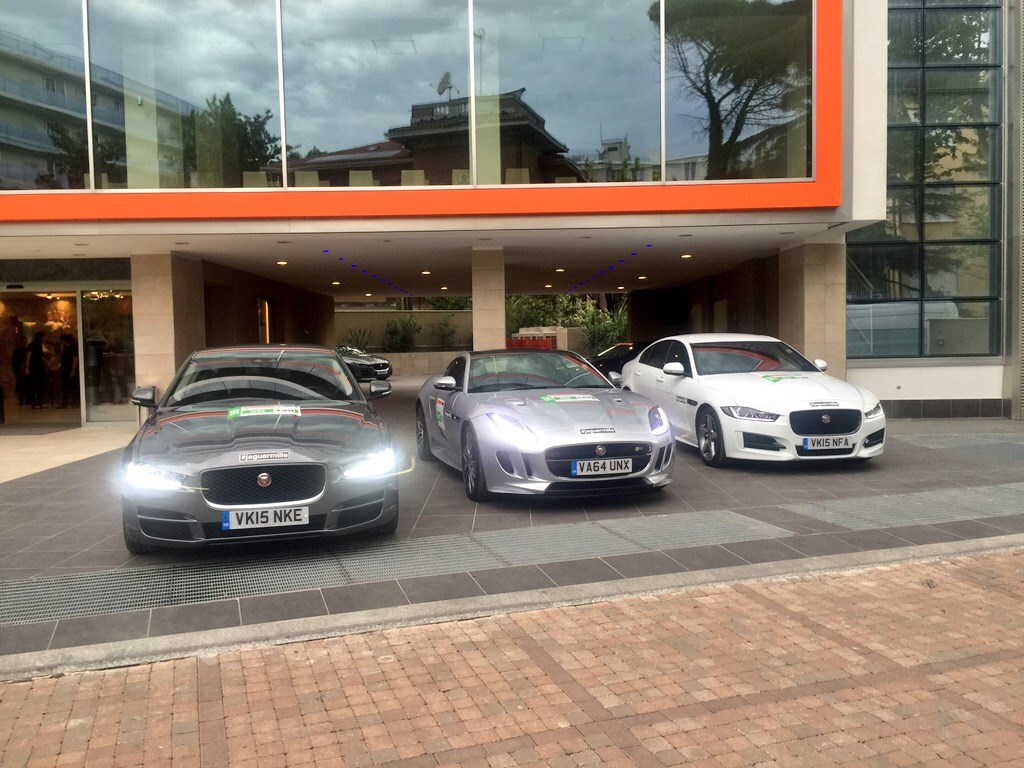
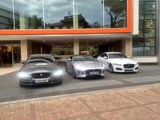
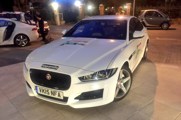
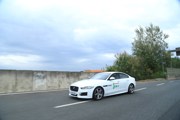
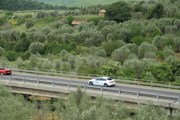













Simon ford - 12/06/2015 21:04
Great article, and great pictures enjoyed the read